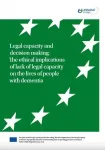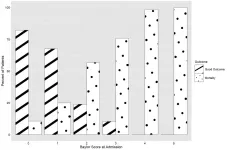(Press-News.org) Nanoengineers at the University of California San Diego have developed a "wearable microgrid" that harvests and stores energy from the human body to power small electronics. It consists of three main parts: sweat-powered biofuel cells, motion-powered devices called triboelectric generators, and energy-storing supercapacitors. All parts are flexible, washable and can be screen printed onto clothing.
The technology, reported in a paper published Mar. 9 in Nature Communications, draws inspiration from community microgrids.
"We're applying the concept of the microgrid to create wearable systems that are powered sustainably, reliably and independently," said co-first author Lu Yin, a nanoengineering Ph.D. student at the UC San Diego Jacobs School of Engineering. "Just like a city microgrid integrates a variety of local, renewable power sources like wind and solar, a wearable microgrid integrates devices that locally harvest energy from different parts of the body, like sweat and movement, while containing energy storage."
The wearable microgrid is built from a combination of flexible electronic parts that were developed by the Nanobioelectronics team of UC San Diego nanoengineering professor Joseph Wang, who is the director of the Center for Wearable Sensors at UC San Diego and corresponding author on the current study. Each part is screen printed onto a shirt and placed in a way that optimizes the amount of energy collected.
Biofuel cells that harvest energy from sweat are located inside the shirt at the chest. Devices that convert energy from movement into electricity, called triboelectric generators, are positioned outside the shirt on the forearms and sides of the torso near the waist. They harvest energy from the swinging movement of the arms against the torso while walking or running. Supercapacitors outside the shirt on the chest temporarily store energy from both devices and then discharge it to power small electronics.
Harvesting energy from both movement and sweat enables the wearable microgrid to power devices quickly and continuously. The triboelectric generators provide power right away as soon as the user starts moving, before breaking a sweat. Once the user starts sweating, the biofuel cells start providing power and continue to do so after the user stops moving.
"When you add these two together, they make up for each other's shortcomings," Yin said. "They are complementary and synergistic to enable fast startup and continuous power." The entire system boots two times faster than having just the biofuel cells alone, and lasts three times longer than the triboelectric generators alone.
The wearable microgrid was tested on a subject during 30-minute sessions that consisted of 10 minutes of either exercising on a cycling machine or running, followed by 20 minutes of resting. The system was able to power either an LCD wristwatch or a small electrochromic display--a device that changes color in response to an applied voltage--throughout each 30-minute session.
Greater than the sum of its parts
The biofuel cells are equipped with enzymes that trigger a swapping of electrons between lactate and oxygen molecules in human sweat to generate electricity. Wang's team first reported these sweat-harvesting wearables in a paper published in 2013. Working with colleagues at the UC San Diego Center for Wearable Sensors, they later updated the technology to be stretchable and powerful enough to run small electronics.
The triboelectric generators are made of a negatively charged material, placed on the forearms, and a positively charged material, placed on the sides of the torso. As the arms swing against the torso while walking or running, the oppositely charged materials rub against each and generate electricity.
Each wearable provides a different type of power. The biofuel cells provide continuous low voltage, while the triboelectric generators provide pulses of high voltage. In order for the system to power devices, these different voltages need to be combined and regulated into one stable voltage. That's where the supercapacitors come in; they act as a reservoir that temporarily stores the energy from both power sources and can discharge it as needed.
Yin compared the setup to a water supply system.
"Imagine the biofuel cells are like a slow flowing faucet and the triboelectric generators are like a hose that shoots out jets of water," he said. "The supercapacitors are the tank that they both feed into, and you can draw from that tank however you need to."
All of the parts are connected with flexible silver interconnections that are also printed on the shirt and insulated by waterproof coating. The performance of each part is not affected by repeated bending, folding and crumpling, or washing in water--as long as no detergent is used.
The main innovation of this work is not the wearable devices themselves, Yin said, but the systematic and efficient integration of all the devices.
"We're not just adding A and B together and calling it a system. We chose parts that all have compatible form factors (everything here is printable, flexible and stretchable); matching performance; and complementary functionality, meaning they are all useful for the same scenario (in this case, rigorous movement)," he said.
Other applications
This particular system is useful for athletics and other cases where the user is exercising. But this is just one example of how the wearable microgrid can be used. "We are not limiting ourselves to this design. We can adapt the system by selecting different types of energy harvesters for different scenarios," Yin said.
The researchers are working on other designs that can harvest energy while the user is sitting inside an office, for example, or moving slowly outside.
INFORMATION:
Paper: "A Self-Sustainable Wearable Multi-Modular E-Textile Bioenergy Microgrid System." Co-authors include Kyeong Nam Kim*, Jian Lv*, Farshad Tehrani, Muyang Lin, Zuzeng Lin, Jong-Min Moon, Jessica Ma, Jialu Yu and Sheng Xu.
*These authors contributed equally to this work.
This work was supported by the UC San Diego Center for Wearable Sensors and the National Research Foundation of Korea.
Charcot-Marie Tooth disease is the most common hereditary neurological disease in the world. It affects the peripheral nerves and causes progressive paralysis of the legs and hands. No treatment is currently available to fight this disease, which is due to the overexpression of a specific protein. Scientists from the CNRS, INSERM, the AP-HP and the Paris-Saclay and Paris universities have developed a therapy based on degrading the coding RNA for this protein in mice. Their work is patented and was published on 9 March 2021 in Communications Biology.
In molecular biology, transcription is when a DNA molecule is copied to make an RNA molecule. This RNA molecule is then "translated" into a protein, which can perform different functions within the body's cells. When a specific protein called ...
Modern hospitals and antibiotic treatment alone did not create all the antibiotic resistant strains of bacteria we see today. Instead, selection pressures from before widespread use of antibiotics influenced some of them to develop, new research has discovered.
By using analytical and sequencing technology that has only been developed in recent years, scientists from Wellcome Sanger Institute, University of Oslo and University of Cambridge have created an evolutionary timeline of the bacterium, Enterococcus faecalis, which is a common bacterium that can cause antibiotic resistant infections in hospitals.
The results, published today (9th March 2021) in Nature Communications ...
An increase in overall hospitalizations was reported for older adults in the week following exposure to a tropical cyclone, according to a new study by researchers at Columbia University Mailman School of Public Health, Columbia University's Earth Institute and colleagues at Colorado State University and Harvard T. H. Chan School of Public Health.
The researchers used data over 16 years on 70 million Medicare hospitalizations and a comprehensive database of county-level local winds associated with tropical cyclones to examine how tropical cyclone wind exposures ...
Luxembourg, 9 March 2021 - Today, Alzheimer Europe launches a new report, "Legal capacity and decision making: The ethical implications of lack of legal capacity on the lives of people with dementia", which looks at the intersection between legal rights and ethical considerations in relation to legal capacity and decision making.
The working group responsible for the report was set up by Alzheimer Europe in 2020 and was composed of experts in dementia, law, ethics, policy, research, psychology and the experience of having dementia and supporting people with ...
MUNICH -- Around the world each year, extreme precipitation events cause catastrophic flooding that results in tragic loss of life and costly damage to infrastructure and property. However, a variety of different weather systems can cause these extreme events, so a detailed understanding of the atmospheric processes that lead to their formation is crucial.
Now, for the first time, a global analysis reveals that two intertwined atmospheric processes drive the formation of many large-scale extreme precipitation events around the world, particularly in dry subtropical regions where they can inflict catastrophic flooding, as occurred in March 2015 in the Atacama Desert.
Previous research on extreme precipitation events ...
CHAMPAIGN, Ill. -- A six-week training program designed to strengthen resilience against emotional distress in military veterans was associated with positive changes in brain function and increased confidence in their ability to regulate emotions, researchers report.
Published in the journal Frontiers in Psychology, the new proof-of-concept study tested two approaches for building emotional resilience in 19 veterans. The first involved weekly, 90-minute group therapy sessions focused on sharing and skills-building in 10 participants. The second trained nine veterans in the use of specific emotion-regulation strategies that previous ...
CHARLOTTESVILLE, VA (MARCH 9, 2021). In 2014, the Journal of Neurosurgery published a paper by a group of researchers from Baylor College of Medicine in Houston, who developed a prognostic scoring system for use in patients who present to the emergency department with a gunshot wound to the head (GSWH).[1]
Today, we publish two papers by a group of researchers at Vanderbilt University Medical Center that extend our understanding of the Baylor GSWH scoring system and its application, externally validating it in a different group of patients presenting during a more recent time period in which ...
People living with a patient undergoing an intensive weight loss treatment also benefit from this therapy. This has been demonstrated by a team of researchers from the Hospital del Mar Medical Research Institute (IMIM-Hospital del Mar) along with doctors from Hospital del Mar and the CIBER on the Physiopathology of Obesity and Nutrition (CIBERObn), in collaboration with IDIAPJGol, the Pere Virgili Health Research Institute (IISPV), IDIBELL, IDIBAPS and the Sant Joan de Reus University Hospital. The study has been published in the journal International Journal of Obesity.
The study analysed data ...
About 11% of women who carry to term will experience prelabor rupture of membrane--a condition where the amniotic sac breaks open early, but labor doesn't begin.
Typically, when a woman's water breaks but labor doesn't start, labor is induced. But a new University of Michigan study found that expectant management--waiting a period of time after the water breaks for labor to begin spontaneously--did not significantly increase risk to the fetus or the mother in healthy pregnancies.
Therefore, both induction and expectant management should be considered, and the decision should be made in the context of the mother's wishes and health, said study ...
People who frequently try to impress or persuade others with misleading exaggerations and distortions are themselves more likely to be fooled by impressive-sounding misinformation, new research from the University of Waterloo shows.
The researchers found that people who frequently engage in "persuasive bullshitting" were actually quite poor at identifying it. Specifically, they had trouble distinguishing intentionally profound or scientifically accurate fact from impressive but meaningless fiction. Importantly, these frequent BSers are also much more likely to fall for fake news headlines.
"It probably seems intuitive to believe that you can't bullshit ...



